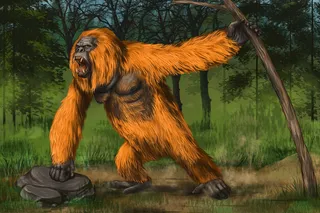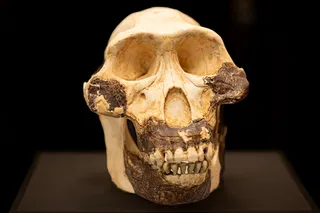Sandra Olsen stands knee-deep in summer grass on a sprawling plain in northern Kazakhstan, peering at horse herders creeping antlike over a golden hill miles away. Kazakhs have roamed this cold dry grassland on horseback for centuries and are renowned for their ability to shoot arrows with accuracy while bouncing atop galloping steeds. As Olsen watches mammoth clouds gathering on the horizon, she envisions a time thousands of years ago when these plains were inhabited by hardy hunter-gatherers who lived on horse meat but did not know how to ride the horses they hunted. She muses on how radically their world must have changed when one of them finally climbed aboard a horse, tamed it, and rode like the wind. "Prior to horseback riding, most people carried all their cargoon their shoulders, or they were restricted to using boats along rivers and coastlines," says Olsen, an archaeologist at the Carnegie Museum of Natural History in Pittsburgh. "Horses were swift of foot, could easily support one or two human passengers, carry heavy loads, and survive on very poor quality vegetation or fodder. They were our first form of rapid transit."
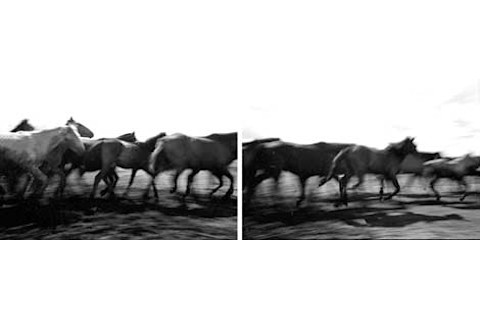
Temporarily freed from a small corral, Kazakh horses test their legs. "No animal has made a greater impact on societies than the horse," says archaeologist Sandra Olsen.
Ultimately, the taming of horses turned out to be a momentous turning point in human history. "Horses caused the first globalization," says Melinda Zeder, an archaeologist at the Smithsonian Institution in Washington, D.C. "They allowed cultures to grow from isolated pockets to interconnected spheres of influence." Archaeologists generally agree that this historical upheaval began in the only region on Earth where horses survived in significant numbers after the Ice Age: the vast Eurasian steppe that stretches from the Carpathian Mountains in Hungary to the Alta’ Mountains in Mongolia thousands of miles away. Researchers also agree that domestication occurred before 3000 B.C., when horses suddenly started showing up in distant places like Turkey and Switzerland. But one of the most enduring archaeological mysteries has yet to be resolved. Who were the original horsemen, and what inspired them to straddle a 1,000-pound beast that could kick out their brains with one blow? Every summer Olsen returns to this spot in the heart of the Eurasian steppe, hoping to prove that her version of history is correct. Beneath her black Reeboks and the knee-high grass lies a village that a primitive people known as the Botai lived in 6,000 years ago. Excavations at this site, dubbed Krasnyi Yar, and another site less than 100 miles to the west, have revealed that the Botai endured a harsh existence. They lived in pit houses dug into the ground and half-covered with some structure that has since rotted away. During winter, which lasts nearly nine months of the year, they dressed in the furs of various small mammals, huddled around fires, and ate horse meat. And they left behind some clues: Their pit houses are chock-full of bones, 90 percent of them from horses. What's not immediately evident is whether those horses were wild or tame, or both. But after eight years of careful detective work, Olsen thinks she has deciphered the tale the bones have to tell. The Botai people not only hunted and herded horses for food, she says, they also used them as a means of transport. If she's right, then she has found the earliest-known horsemen and, quite possibly, the inventors of riding.
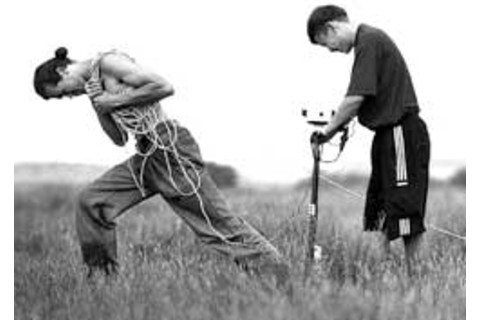
At the Krasnyi Yar dig site, Timur Nurseitov marks off a grid with rope while Asker Tulebaev hunts buried pit houses using a device that measures soil density.
Olsen and her team have set up camp in a copse of windswept trees a few hundred yards from the ancient Krasnyi Yar site. There are two dozen sleep tents, a large circular-domed yurt that serves as the mess hall, and a rusty mobile home referred to by the Russian word vagon.The vagon is Olsen's lab, complete with microscopes, measuring tools, laptop computers, and a growling propane generator. It's the little house on the prairie where Olsen, a native Kansan, brings a long-lost world alive. "I don't care much for living horses," she says, conscious of the irony. "It's their bones I like." Archaeologists who study the domestication of other animals have a much easier time analyzing skeletal artifacts. "With dogs, pigs, sheep, and cattle, you can see morphological changes in their bones" over time, says Olsen, sitting on a small wooden chair that looks like it was borrowed from a grade school. For example, when dogs were tamed and bred to be much more docile than their wild wolf cousins, their snouts and their brain cases changed shape. Likewise, domesticated cows are much smaller than the now-extinct aurochs from which they descended. Nothing like that happened with horses. "It would be great to pick up a bone and say, 'This was a wild horse, this was a tame horse,'" says Olsen as she plucks a phalanx (toe bone) from the plethora of skeleton parts scattered about the vagon. "But we can't. For all we know from its shape, it could be modern, it could be Ice Age, it could be Botai domesticated, it could be Botai wild." Still, the bones do offer information. "For a long time, people thought they could get around the lack of morphological changes by looking for other marks that showed domestication, most notably bit-wear on the teeth," says Olsen. In the early 1960s Russian archaeologists excavated a 6,000-year-old site in Ukraine called Dereivka, where they found a stallion skull that had distinctive beveling on its teeth. They thought that was unequivocal evidence of a riding bit. As a result, the Sredny Stog people who had inhabited the site in prehistoric times "went in all the textbooks," says Olsen, as the earliest known horseback riders. But some scientists, including Olsen, remained skeptical. "I mean, how are you going to get hard-metal scrape marks on a Copper Age tooth?" she asks, shaking her head. Then, three years ago, new radiocarbon-dating techniques revealed that the skull was actually 2,400 years old. "It was an Iron Age horse whose grave had been dug down into a more ancient settlement," says Olsen.

Olsen measures the radius bone from a foreleg of a prehistoric horse found at Krasnyi Yar in order to make size comparisons with the bones of modern horses.
There will be no such obvious clues in Krasnyi Yar, but Olsen is quite content to slowly tease subtle evidence from her cache. After measuring the size of individual bones and carefully examining the teeth, she runs statistical tabulations for breakdowns of the horse population by gender and age at the time of death. Then she looks for mortality patterns that might help distinguish domesticated stock from victims of the hunt. Zeder of the Smithsonian pioneered this technique in a study of goat domestication at a site in Iran. She discovered that the people who lived there 9,000 years ago killed off most of the male goats by age 2, about the time they reached sexual maturity. The females were allowed to live past 4. If the people were killing wild goats, this mortality pattern wouldn't make any sense, says Zeder. "The hunter is after the bigger meat package. To maximize the hunt, he kills adult male goats, not 2-year-olds." The pattern makes sense for livestock and is still a standard practice of modern goat herders, who keep a few select males around for reproduction but kill off the rest before they start making trouble. The mortality pattern Olsen has found among horses at the Botai sites is similar to the hunting pattern Zeder predicted for goats: The males are fully grown and slightly outnumber females. "But," Olsen says, "hunting horses is different from hunting goats, and domesticated horses are not just livestock." Wild horses live in two groups: families and bachelors. Families consist of a single stallion, a half-dozen females, and their young; bachelor pods consist of two or three young males. "The families stick together when they're attacked," Olsen says. "But the male twosomes have no loyalty. They'll just take off in opposite directions." The way to maximize a horse hunt is to attack the mostly female families. So if the Botai were just horse hunters, Olsen reasons, she'd be seeing many more female bones around their pit houses. Olsen says one other difference between the mortality patterns of goats and horses may be more significant. Unlike goat herders, who can afford to cull young males because humans don't ride goats, ancient horsemen would likely keep young males alive and ride them, which suggests that a purely domestic mortality pattern for horses might be weighted heavily toward older males, Olsen says. But the Botai mortality pattern is more balanced. She offers a simple explanation: "They hunted wild horses from horseback."
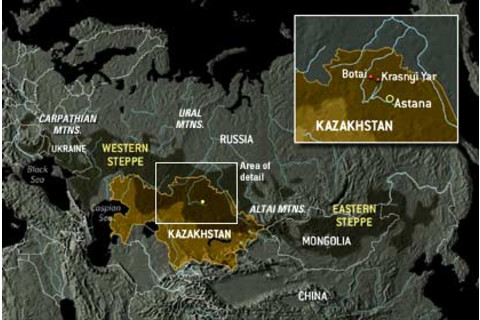
Humans have hunted horses across the Eurasian steppe for at least 100,000 years. Analysis of bones found at two sites near Astana, the capital of Kazakhstan, suggests that 6,000 years ago, the Botai people were the first to turn their prey into a means of transport. Graphic by Matt Zang
In the process of measuring the Botai horse bones, Olsen says she found other, very large clues staring her in the face: "Full skeletons of horses, entire vertebral columns, and pelvises. The Botai didn't just leave behind horse parts. They've got whole horses." Olsen is tall and fit enough to lug water crates, dig trenches, and perform the various chores of running a dig in the middle of the wide-open steppe. But the muscle power required to heft giant horse bones on and off the measuring table made her think of the Botai in the same spot 6,000 years ago: How far would they have been willing to move whole horses? "I don't think they went out, miles overland on foot, killed a horse, and dragged the whole 1,000-pound thing back here," she says. They'd more likely butcher a wild horse in the field, divide up the meat for easy carrying, and leave heavy and nonnutritious parts behind. In that case, she argues, you wouldn't find the spine and hips in the Botai village pit houses. "Yet we find them," says Olsen, who suggests that the full skeletons are the remains of domesticated horses as well as wild horses hauled home whole by means of living horses. She calls this bit of reasoning "the schlep effect." The schlep effect should also extend to other materials. Olsen is curious about quartzite stone scrapers she found at Krasnyi Yar, so she has sent out graduate students on geological surveys to find the quarry, which, even after 6,000 years, should still be visible. They haven't found it, and if it turns out to be a great distance away—more than 50 miles—she'll argue that the Botai must have had horses to go so far on a regular basis. But stone chips and flakes unearthed in recent excavations indicate that the Botai were carrying home chunks of rock larger than a human could carry long-distance. A light rain falls as a monstrous thunderhead passes to the north, raising a rapid-fire din on the tin roof of the vagon and dousing the far-off horse herders. Meanwhile, Olsen, an avid outdoorswoman who is usually disappointed to be forced inside by nasty weather, uses the time to consider how the earliest riders may have developed the first horse tackle.
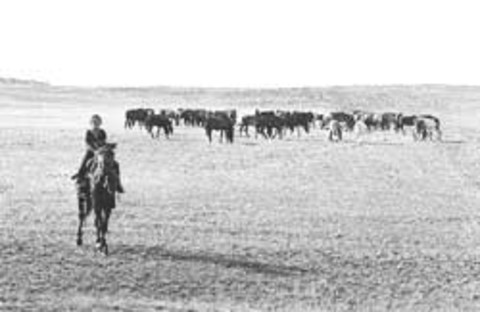
A 9-year-old boy herds his family horses some 12 miles west of Krasnyi Yar. Every rural Kazakh boy is taught to ride by age 4.
"They probably had a simple bridle made of hide or hemp," she says, drawing a little schematic of a rope looped around the front teeth of a horse's skull. They might also have had lassos, whips, tethers, and hobbles of the same material. Most of the tackle we now associate with horses, from saddles to stirrups, are sophistications that were invented well into the history of riding. Because of the Dereivka bit-wear fiasco, Olsen has had little interest in pursuing direct evidence for riding gear. Nonetheless, there is indirect evidence so plentiful among the Botai horse bones that she can't ignore it. Hundreds of jawbones have tiny rubbing marks on them. These marks aren't evidence of riding, Olsen says. That part of the jaw is covered in flesh when a horse is alive. But Olsen thinks the Botai may have used tools fashioned out of horse jawbones as a tool to make their riding ropes. She grabs a boomerang-shaped horse jaw to explain. "This is a thong smoother," she says, pointing to the inside curve of the boomerang. "Using a scanning electron microscope, we've looked at this notch on dozens of these jawbones, and they've all been worn down by the rubbing of some sort of leather," she says. "If you put a strip of hide in the notch and pull it back and forth, any bendy piece will straighten out into strong usable leather," she explains. Without a thong smoother, the longest piece of straight leather one can make is the same length as a horsehide, about six feet. With a thong smoother, the hide can be cut in a spiral, then straightened to create a strip of leather a dozen yards long. Olsen points out that the Botai had more thong smoothers than cooking pots. "It's a regular thong factory out here. I don't think they built their homes with them." Botai houses are 175-square-foot pits that would have been covered with thatch or adobe mud. "It's a deductive argument to say that they're making horse tackle. But they used them for something," she says. Unable to avoid the rain any longer, Olsen dashes to the nearby yurt for lunch: a traditional bowl of buckwheat groats, called gretchka, which she and her colleagues Bruce Bradley and Alan Outram don't exactly love. "But it's pretty good for out here," says Outram, a proper young British lecturer in archaeology at Exeter University in England. Olsen tells Outram and Bradley about the artifacts she and other archaeologists unearthed at the other Botai site in the years before they joined her dig here at Krasnyi Yar. Among the hundreds of thong smoothers and stone scrapers, there are bird bones made into awls and beaver jaws used for woodworking. There are also lots of marmot foot bones, which suggest that the Botai wore marmot furs but didn't bother to debone the tiny feet. Most of the pit houses have dog burials near the west door: The dogs that guarded the house in life could ritually guard it after death.

In a makeshift field office, Olsen catalogs various artifacts on her laptop. "I came into equestrian studies through the back door, by studying the bones of ancient horses," she says.
Olsen turns excitedly to the topic of human burial, a subject archaeologists apparently deem suitable mealtime conversation. There aren't many human bones at the Botai sites, she says. Perhaps they didn't bury their dead, or perhaps they buried them some distance from the houses, and those graves haven't been found. But there is evidence from two ritual burials at the other Botai site, and the more she becomes convinced that the Botai rode horses, the more sense the burials make. The evidence from one burial includes a decapitated human skull found in a pit, with traces of a yellow clay mask and two little holes bored through the crown. "I looked at the skull with a scanning electron microscope to see how they'd skinned him," Olsen says. "It was done with great respect, with slow, careful cuts. Then they put flesh-toned clay on him. Perhaps the holes were for tying on a wig of some sort so that the skull resembled him in life." The effigy was laid to rest in a pit with the tools of his trade: a thong smoother, a hunting arrow, and the jaws of a horse. In a second burial, two men, a woman, and a child were found in a large pit encircled with the skulls, vertebrae, and pelvises of 14 horses. "A family with their mounts," Olsen says. "It would be a truly remarkable ritual if these were 14 wild horses," especially because the schlep problem would have involved 14,000 pounds of horseflesh, says Bradley. Outram's specialty is determining how ancient people used animal fats, and Olsen has asked him to investigate another line of evidence that could bolster her argument that the Botai rode horses. Modern-day Kazakhs make a lightly fermented mare's milk drink called koumiss. Olsen says it "tastes like stomach bile," but Kazakhs love it, and it has been a staple of the steppe horse herders' diet since before anyone can remember. Maybe, Olsen reasons, it goes all the way back to the Botai. So she has asked Outram to test Botai pottery shards for mare's milk. Outram first journeyed into remote Kazakh villages to collect regional samples of mare's milk. The herders, most of whom had never seen a Westerner, obliged with proud smiles, milking their mares into wooden pails and pouring the thin white liquid into Outram's lab-sterile plastic bags. He also cut chunks of fat from carcasses at local meat stalls. Back in England, his laboratory task will be to distinguish lipid compounds found in horse fat (which could linger in the pots of people who only hunted horses) from lipid compounds found exclusively in the milk. If he can identify mare's-milk lipids in Botai pottery, then he has proof they were milking horses. "Unless you're going to tell me they're milking wild horses," says Olsen, laughing. If Olsen's work convinces other archaeologists that the Botai rode horses—and others are beginning to accept the concept—she will have identified the earliest known riders. That still won't mean they were the first, she says: "Archaeologists tend not to ask the question 'Did it happen here first?' It's enough for us to say, 'This is the earliest evidence we've got.'"

Kazakh horsemen race for the finish line in a grueling 20-minute-long endurance race. "Any local festival in Kazakhstan is an excuse for horse games," says Olsen.
Some archaeologists, like David Anthony of Hartwick College in upstate New York, find the Botai implausible first horse tamers. Anthony contends that "horses almost certainly were first domesticated for use as food animals, like cattle or pigs," by a culture, like the Sredny Stog, already practiced in the art of herding cattle. Olsen responds: "I think you get yourself into trouble if you start making presumptions about what is plausible and what is not. Human beings are weird and imaginative. They frequently do implausible things," such as get on the back of a creature that charges overland at 30 miles an hour. Outside the yurt, the rain has passed. The bright sun on the summer grass is all the more beautiful for its contrast with the purple storm still lingering on the horizon. For horses this steppe is paradise, an endless sea of grass. For humans it is a harsh and unforgiving place. It's easy to see how, 6,000 years ago, the Botai people's reliance on horses could have been absolute. And it's not hard to imagine the immense benefits they would have gained by bringing the horse under their control, domesticating it. Horses in the corral are larder for the long winter. Horses that have been tamed for riding make the distance to the horizon, and the next wild horse, less daunting. Most archaeologists dismiss as hindsight the notion that a people invented something because they knew the range of its benefits. Like the inventors of gunpowder, the cotton gin, or the Internet, the first horseback riders likely had no idea of the power of their discovery. Perhaps it was merely a daydreamer loafing in summer grass who envisioned mounting a horse. Perhaps it was a daredevil showing off to his friends, leaping from a tree onto the back of a colt and hanging on to the mane for his life. And, muses Olsen as the distant horse herders emerge from the storm, "perhaps it happened here." Tamed Kingdom Humans have domesticated numerous animal species over the past 12 millennia, beginning with man's best friend, the dog. Here is a sampling of roughly when and where the taming of some familiar critters occurred.
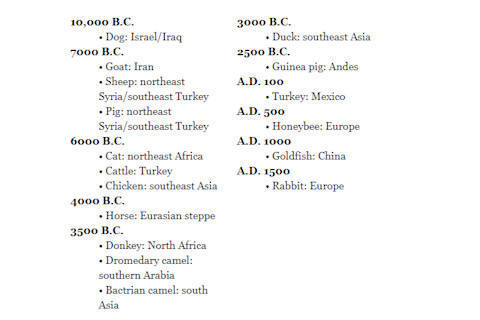
Web Resources:
For more about Sandra Olsen's work, see her home page at the Carnegie Museum of Natural History: www.carnegiemuseums.org/cmnh/anthro/olsen_home.html#research. For more information about Krasnyi Yar, see the University of Exeter page: www.ex.ac.uk/archaeology/rhorse.html.





